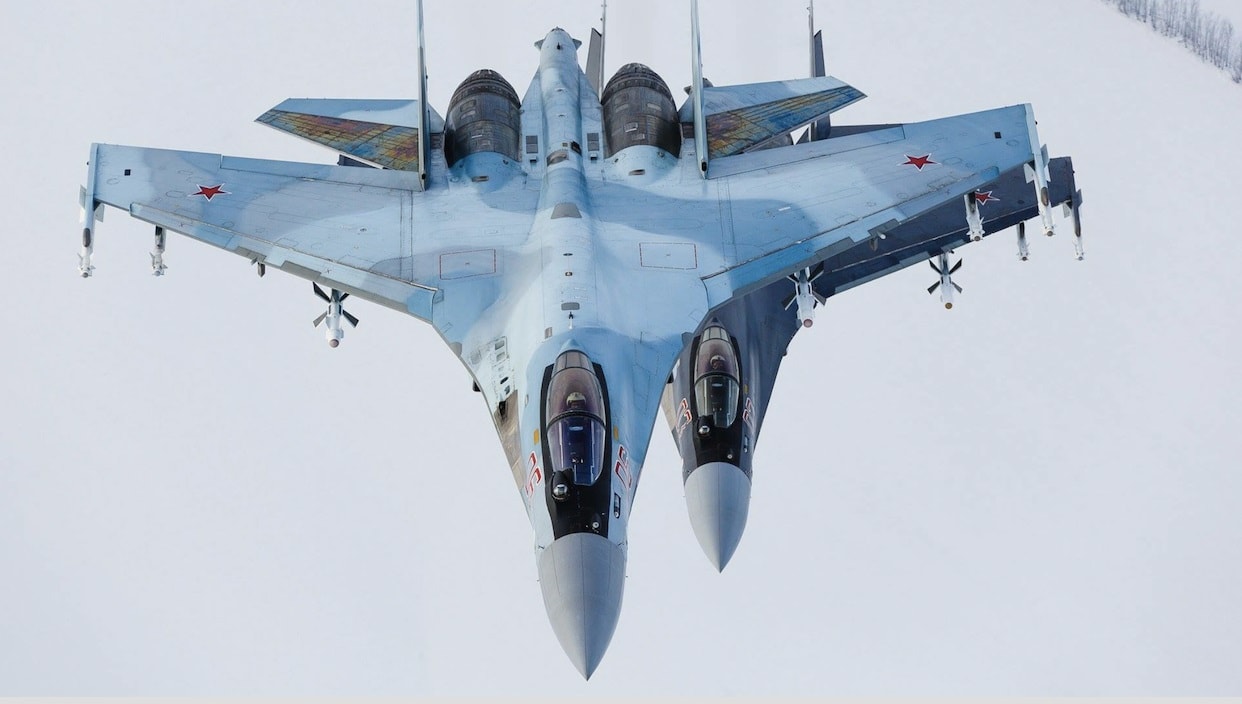Russia appears to be using its most advanced operational fighter – Su-35 – employing at least half a century-old tactics!
Outfoxed By Iran, US, UK Navy Conduct Drills With The Same Surveillance Drone That Tehran Seized In Persian Gulf
Ukraine War: Fiery US Weapon Has Been Voted The ‘Coolest Thing Made In Arkansas,’ Here’s What Gives It A ‘Cult Status’
The Russian armed forces are not on the verge of collapse. And No! The Su-35 doesn’t lack the capability associated with it. And certainly not! Russian fighter pilots are not a bunch of kick-the-tire and light-the-jocks!
The apparent regression in employed tactics likely has an excellent reason. Russian forces appear to be adapting to the realities of a protracted conflict against an adversary drawing on an unending supply of troops, equipment, and ammunition from the West.
Reverting to proven old tactics is part of an approach that will allow Russia to fight for as long as it takes.
Su-35 – Affordable Capability
Russia chooses to keep its weapon systems affordable, often sacrificing capability in favor of affordability. The approach is justified, not just because the Russian ability to spend on defense is limited (its annual defense budget is less than India’s), but also because of the advantages of such an approach.
An affordable weapon system platform allows you to absorb limited losses while giving warriors more flexibility in employment. Increased risk to the platform becomes an option. The Su-35 is an example of affordable excellence!
It’s a skillful air combat and ground attack fighter with characteristics – sensor fusion & supermaneuverability – of a 4.5 generation aircraft.
For ground attack, it can carry sensors & weapons that allow it to engage a ground target from medium altitude (out of MANPAD range) using stand-off weapons while suppressing enemy air defense (SEAD) systems. There is no need for a Su-35 to operate at low altitudes increasing risk from MANPADS.
Unconventional Employment
Yet, in this video posted on Telegram, we see two RuAF Su-35s engaging a ground target in Ukraine in a very old-fashioned way at low altitudes within the MANPAD envelope!
One Su-35 mounts a CAP (Combat Air Patrol) overhead to detect threats, such as adversary aircraft & MANPAD launches. At the same time, the other descends to a very low height (3-500 ft above ground) and drops a bomb on a target making a relatively slow-speed bombing run.
Assuming no long lens was used, the bombing run was made from between 3-500 ft.
Here is the interesting detail, the target likely is a Ukrainian S-300 installation, going by the glimpses of a large erect vertical launch canister and the mast of a radar designed to detect low-flying aircraft. Notably, the attacking Su-35 is equipped with wingtip-mounted Khibiny EW pods.
This video grab shows what appears to be a missile canister
A video grab shows what seems to be a radar mast.
Before continuing, let me point out that no two F-35s would engage a ground target as the two Russian Su-35s do. Not even in an uncontested battlespace such as Syria, let alone Ukraine! The price tags on the F-35 would make the risk level unacceptable.
Imperatives Of A Protracted Conflict
So why would a 4.5 Gen fighter aircraft expose itself to MANPADS and other adversary AD missiles to attack a ground target with a dumb bomb? Why not strike it with a cruise missile or a smart stand-off bomb?
Here are the possible reasons why the RuAF would choose to engage the target in the old-fashioned or, say, the non-American way.
-
The S-300 is a mobile AD system that rules out attacks using cruise missiles because they require target coordinates to be known before launch. A mobile target must be hunted down using satellites or ISR aircraft-based electronic & optical eavesdropping. Russia doesn’t have the resources.
-
Attacking an S-300 system from medium altitudes – using a targeting pod and inertially guided bomb with a terminal optical seeker – would be complex because the S-300 has a very long reach & very high lethality against medium-altitude targets. For Russia, the option is likely also unaffordable in a protracted conflict.
-
Dumb bombs dropped from low altitudes can be as accurate as smart bombs dropped from medium altitudes and stand-off distances.
-
The Khibiny electronic-warfare self-defense system fitted on the Su-35 can detect & dupe surveillance & tracking emissions of AD radars & missiles. Missile Approach Warning (MAW) sensors and CAP eyeballs can alert Su-35 pilots to MANPAD launches.
-
The Su-35’s supermaneuverability would add to the protection accruing from the self-protection suite of the fighter. With adequate warning, the Su-35 can outmaneuver a MAPAD
-
Russia is likely conserving its inventory of smart stand-off bombs.

Seek & Destroy Works
Considering the above, if the presence of an S-300 battery in an area is known, an old-fashioned seek-and-destroy mission can be a very good option to neutralize it.
Seek and destroy, as the name suggests, entails going to the target area, visually acquiring the target, and then attacking, ensuring the absence of threats by setting up a CAP.
Using modern terminology, mounting the CAP would establish local air superiority! Really, there is a lot of old wine in new bottles.
Defense planners in India are likely closely following the ongoing Russian Special Military Operations (SMO). The fact that the SMO has turned out to be protracted needs New Delhi to rethink some of its assumptions – most importantly, the belief that their future wars will be short-lived.
As Russia finds out, short-lived operations may not allow war aims to be achieved. So India must be prepared for long wars, using weapon systems, ammunition, sensors, and tactics suited to a protracted conflict.
- Vijainder K Thakur is a retired IAF Jaguar pilot. He is also an author, software architect, entrepreneur, and military analyst.
- Reach out to the author at vkthakur (at) gmail.com
- Follow EurAsian Times on Google News




